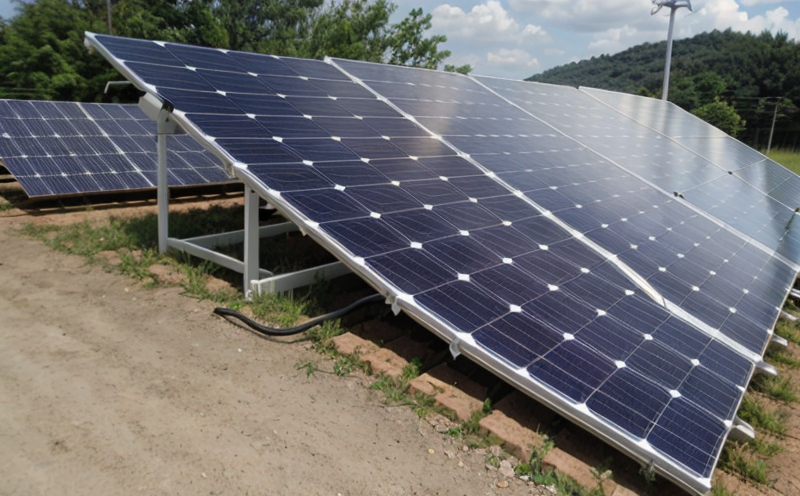IEC 61215-2 Outdoor Weathering Testing
The IEC 61215 series of standards is designed to provide criteria and test methods for the performance, safety, and environmental durability of photovoltaic (PV) modules. Specifically, IEC 61215-2 Outdoor Weathering Testing evaluates the long-term outdoor performance of PV modules under real-world conditions. This testing method simulates natural weathering factors such as ultraviolet radiation, temperature cycling, humidity, and precipitation to assess a module's durability over time.
The primary objective of this test is to ensure that solar panels can withstand harsh environmental conditions without degradation in performance or safety. The test provides a standardized approach to evaluate the aging resistance of PV modules, which is crucial for ensuring their reliability throughout their expected lifespan. This testing method is particularly important as it helps manufacturers and installers make informed decisions about product selection and system design.
The test procedure involves exposing PV modules to outdoor environmental conditions over an extended period, typically several years, depending on the specific requirements of the standards. During this time, the modules are subjected to various stresses that mimic real-world conditions such as temperature cycling between extreme highs and lows, ultraviolet exposure, humidity, and rainfall.
The testing process is complex and involves multiple stages designed to simulate different environmental factors. For example, the temperature cycling part of the test subjects the module to rapid changes in temperature, which can cause materials to expand and contract repeatedly, potentially leading to fatigue and failure over time. The ultraviolet radiation exposure simulates the damaging effects of sunlight on the photovoltaic cells.
Another critical aspect is the humidity conditioning cycle, which involves exposing the modules to high humidity levels followed by a drying period. This process can simulate the corrosive effects of water vapor in humid environments. Additionally, rainfall simulation helps evaluate how well the module's materials and seals resist water ingress.
The results of this testing provide valuable insights into the durability and performance of PV modules under real-world conditions. Compliance with these standards ensures that products meet international quality and safety requirements, thereby enhancing consumer confidence in renewable energy solutions.
- Temperature Cycling: Simulates the effects of repeated temperature changes on materials and components.
- UV Exposure: Assesses the impact of prolonged sunlight exposure on photovoltaic cells.
- Humidity Conditioning: Evaluates how well materials withstand moisture, which is crucial for preventing corrosion.
- Rainfall Simulation: Tests the effectiveness of seals and coatings against water ingress.
This testing method is essential for manufacturers to ensure their products meet stringent international standards. It also helps in identifying potential weaknesses early on, allowing for improvements before commercial release. Compliance with IEC 61215-2 ensures that PV modules are reliable, safe, and capable of delivering consistent performance over extended periods.
Benefits
- Enhanced Product Reliability: Ensures that solar panels can withstand harsh environmental conditions without degradation in performance or safety.
- Compliance with International Standards: Helps manufacturers meet the stringent requirements set by international standards, enhancing product credibility and market access.
- Potential Cost Savings: Early identification of potential issues through testing can lead to cost savings on design modifications before commercial release.
- Informed Decision-Making: Provides valuable insights into the durability and performance of PV modules under real-world conditions, aiding in informed decisions about product selection and system design.
By undergoing IEC 61215-2 Outdoor Weathering Testing, manufacturers can ensure their products meet international quality and safety requirements. This testing not only enhances consumer confidence but also ensures that renewable energy solutions are reliable and capable of delivering consistent performance over extended periods.
Eurolab Advantages
At Eurolab, we pride ourselves on offering comprehensive and accurate IEC 61215-2 Outdoor Weathering Testing services. Our state-of-the-art facilities and experienced technical staff ensure that every test is conducted with precision and rigor, providing reliable results that you can trust.
We use only the latest equipment to replicate real-world environmental conditions as accurately as possible. This allows us to provide accurate and consistent results, which are essential for making informed decisions about product selection and system design. Our team of experts ensures that every step of the testing process is conducted according to the highest standards.
In addition to our technical expertise, we offer a range of additional services to support your testing needs. Whether you need assistance with specimen preparation or require detailed reporting, we are here to help. Our commitment to quality and reliability means that you can rely on us for accurate and consistent results every time.
Quality and Reliability Assurance
We understand the importance of quality and reliability in renewable energy solutions. That's why we take great care to ensure that our testing services meet the highest standards. Our facilities are equipped with the latest technology, ensuring accurate and consistent results.
Our team of experts ensures that every step of the testing process is conducted according to the highest standards. We use only the most advanced equipment available to replicate real-world environmental conditions as accurately as possible. This allows us to provide accurate and reliable results that you can trust.
We also offer a range of additional services to support your testing needs, including specimen preparation and detailed reporting. Our commitment to quality and reliability means that you can rely on us for accurate and consistent results every time.





